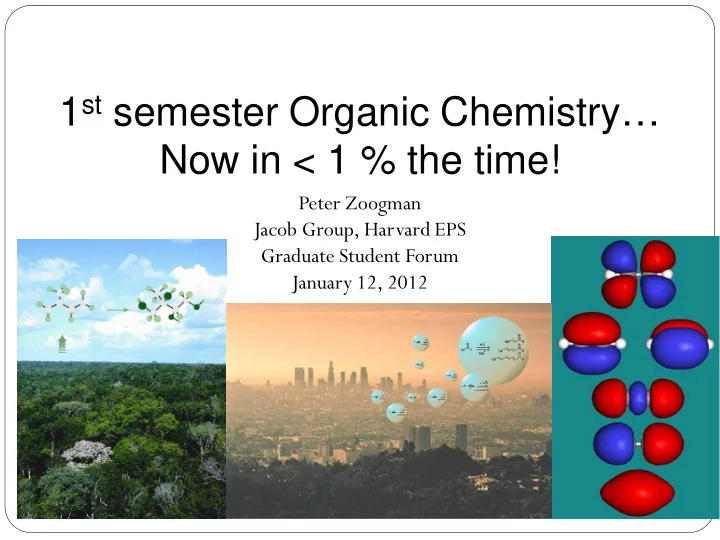

1 st semester Organic Chemistry… Now in < 1 % the time! Peter Zoogman Jacob Group, Harvard EPS Graduate Student Forum January 12, 2012
What is going on? Will a molecule react? What type of molecule will it react with? What bonds are likely to be EARTH SURFACE created/destroyed? What will the product look like?
Molecular Orbitals 2 atomic orbitals combine constructively and destructively to form 2 molecular orbitals Sigma orbital: Pi orbital: One region of overlap Two regions of overlap corresponds to single bond corresponds to double bond σ∗ antibonding π∗ antibonding σ bonding π bonding σ∗ antibonding σ bonding
Molecular Orbital Example –H 2 vs. He H 2 Molecule σ∗ antibonding H Atom H Atom σ bonding
Molecular Orbital Example –H 2 vs. He He 2 Molecule?? σ∗ antibonding He Atom He Atom σ bonding
Molecular Orbitals – Relative Energy σ∗ antibonding π∗ antibonding (lone pairs) π bonding σ bonding
Molecular Orbital Example -- Ethene C-C σ∗ antibonding Ethene: H H C-H σ∗ antibonding C C H H C-C π∗ antibonding C-C π bonding also written as: C-H σ bonding C-C σ bonding
Frontier Orbitals – HOMOs and LUMOs Behaves as electron donor (i.e. Nucleophile, Lewis Base) at Highest Occupied Molecular Orbital (HOMO) Lone pairs (or radicals) π bonds Behaves as electron acceptor (Electrophile, Lewis Acid) at Lowest Unoccupied Molecular Orbital (LUMO) Empty atomic orb. π * antibonding orb. σ∗ antibonding orb.
Molecular Orbital Example -- Ethene C-C σ∗ antibonding Ethene: H H C-H σ∗ antibonding C C H H C-C π∗ antibonding LUMO C-C π bonding HOMO also written as: C-H σ bonding C-C σ bonding
Ethene Hydration What is the HOMO? H O H H C H H C H What is the LUMO?
Ethene Hydration What is the HOMO? H O 2 lone pair O H H C H H C What is the LUMO? H C-C π * antibonding orbital
Ethene Hydration What is the HOMO? H O 2 lone pair O H H C H H C What is the LUMO? H C-C π * antibonding orbital
Ethene Hydration H H H O O H H C H H C H H C H C H H
Ethene Hydration H H H O O H H C H H C H H C H C H H H H H O O H H C C H H H C C H H H H
Molecular Orbitals -- Formaldehyde C-H σ∗ antibonding C-O σ∗ antibonding O C-O π∗ antibonding C O Lone Pairs H H C-O π bonding C-O σ bonding C-H σ bonding
Molecular Orbitals -- Formaldehyde C-H σ∗ antibonding C-O σ∗ antibonding O C-O π∗ antibonding LUMO C HOMO O Lone Pairs H H C-O π bonding C-O σ bonding C-H σ bonding
SOA formation by Polymerization O OH H + C C H H H H O H H
SOA formation by Polymerization O OH O C C H H H H H H OH OH C H H C H OH H O H H
SOA formation by Polymerization O OH O C C H H H H H H OH OH OH C H H C H C OH H H H O H H
SOA formation by Polymerization O OH C C O H H H H H H OH OH C OH H H C H C OH H H H O H H OH C H H H H HO OH C C OH H H O C H OH H
SOA formation by Polymerization
SOA formation by Polymerization
Recommend
More recommend